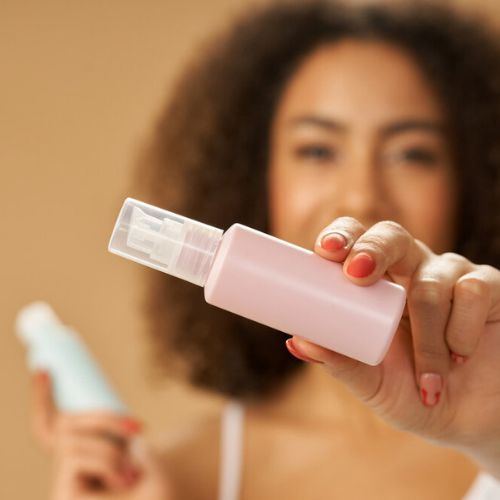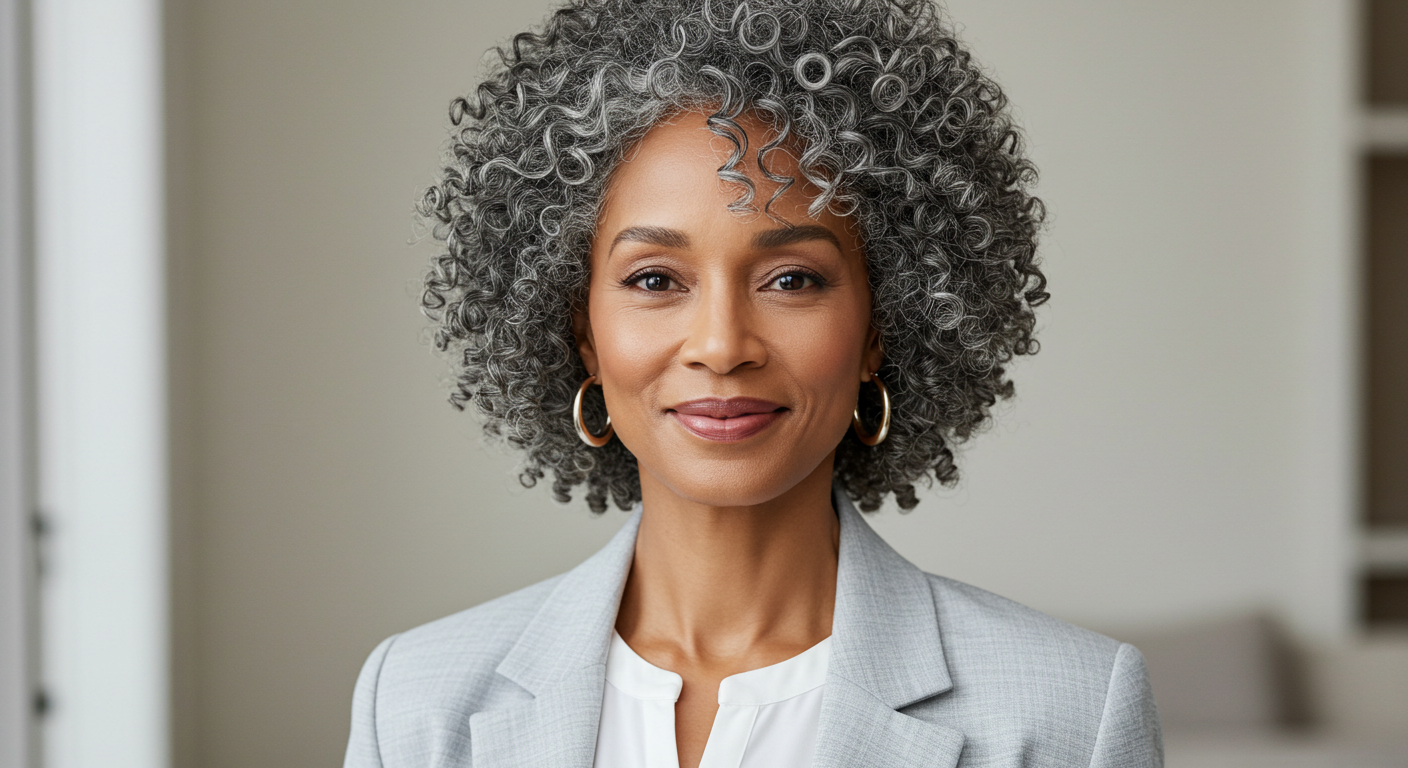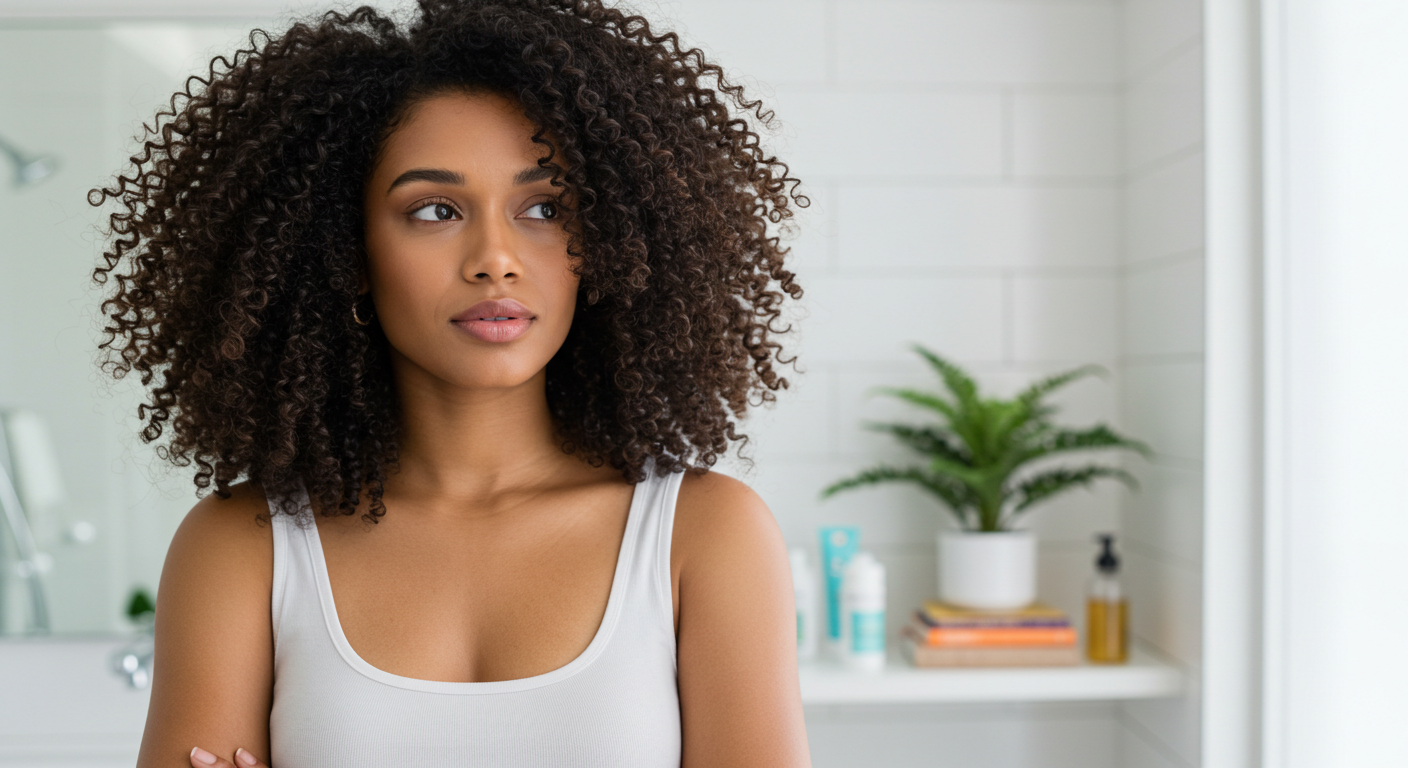When I began my natural hair journey toward healthy hair, I was introduced to a variety of curly hair products, including leave-in conditioner—a term entirely unfamiliar to me. This was entirely new territory for me, as I had neither used nor heard of it back when I relied on chemical straighteners and flat irons for my hair. So, what makes it suddenly so crucial, and what specific function does it serve in curly hair care?
A leave-in conditioner for curly hair is a hair care product formulated to condition, hydrate, and protect your hair strands from external damage. It’s specifically designed to be left in the hair rather than rinsed out, offering continuous moisture and protection all day long.
This isn’t just another item to add to your bathroom clutter. When used the right way, leave-in conditioner becomes the hero your curly hair needs. In this comprehensive guide, created in partnership with a hair scientist who holds a PhD in Chemistry, we’ll reveal how you can use a leave-in conditioner to fully enhance every hair type. You’ll definitely want to bookmark this and share it with a friend. Trust me!
What is a Leave-in Conditioner?

A leave-in conditioner is a specialized hair care product designed to condition, hydrate, and protect hair from external factors.1,2
Unlike traditional conditioners that are rinsed out, it’s applied to either wet hair or damp hair and left in, usually for an extended period. This allows for deeper penetration into the hair shaft, making it more effective in combating issues like dryness, porosity, and breakage.
An ideal leave-in conditioner should possess the following key characteristics:
- Elevate your hair’s moisture content.
- Offer a well-balanced level of emollience or smoothness.
- Enhance the softness and tactile sensation of your hair.
- Shield your hair from chemical oxidation, environmental damage, and UV radiation.
- Avoid imparting any heaviness or greasy residue to your hair.
Choosing the Right Leave-In Conditioner for Different Hair Types and Concerns (Including Key Ingredients)
Hair characteristics can vary significantly based on ethnic background, environmental factors, and current condition. Therefore, a one-size-fits-all approach to selecting a leave-in conditioner may not yield the best results for everyone.
For instance, African-American hair tends to be coily, dry, and highly porous, requiring ingredients that are intensely hydrating and moisture-retaining. On the other hand, Asian hair, which is often straight and coarse, may have low porosity, calling for ingredients that can penetrate the hair shaft effectively.
Here, we break down the different hair needs based on these characteristics and suggest appropriate ingredients for each:
Fine Hair: For Lightweight Hydration and Easy Manageability

- Characteristics: Fine hair needs balanced moisture and ease of manageability.
- Key Ingredients:
- Moisturizing Agents: glycerin, betaine.
- Softening & Detangling Agents: cetrimonium chloride, cetrimonium methosulfate.
- Emollients: sunflower oil, coconut oil, apricot kernel oil, mango seed oil, jojoba oil.
- UV Protection & Antioxidants: green tea extract, chamomile extract.
Wavy Hair

- Characteristics: Lightly wavy hair is often low in porosity and needs moisture, shaft-softening, emollience, and a lightweight formula.
- Key Ingredients:
- Moisturizing Agents: glycerin, panthenol, betaine.
- Softening & Detangling Agents: cetrimonium chloride, behentrimonium chloride.
- Emollients: sunflower oil, coconut oil, apricot kernel oil, mango seed oil.
- UV Protection & Antioxidants: vitamin E, green tea extract, chamomile extract.
Curly Hair

- Characteristics: Curly hair is fragile, often dry, and lacks moisture. It requires rich and concentrated ingredients.
- Key Ingredients:
- Moisturizing Agents: glycerin, propylene glycol, sodium PCA, panthenol, betaine.
- Softening & Detangling Agents: behentrimonium chloride, behentrimonium methosulfate.
- Emollients: Sunflower oil, olive oil, apricot kernel oil, shea butter, babassu butter, mango seed oil.
- UV Protection & Antioxidants: vitamin E, green tea extract, chamomile extract.
Coily Hair

- Characteristics: Coily hair is extremely curly, dry, and highly porous, and sometimes it’s known for its thick hair. It tends to require intense moisture and lubrication.
- Key Ingredients:
- Moisturizing Agents: glycerin, propylene glycol, sodium PCA, panthenol, betaine, aloe vera juice.
- Softening & Detangling Agents: behentrimonium chloride, behentrimonium methosulfate, dicetyldimonium chloride.
- Emollients: sunflower oil, olive oil, apricot kernel oil, shea butter, babassu butter, mango seed oil.
- UV Protection & Antioxidants: vitamin E, green tea extract, chamomile extract, tea tree oil.
Frizzy Hair

- Characteristics: Frizzy hair is damaged, dry, and hard to manage, requiring shaft alignment and moisture.
- Key Ingredients:
- Moisturizing Agents: sodium PCA, panthenol, betaine, glycerin, propylene glycol.
- Softening & Detangling Agents: behentrimonium chloride, behentrimonium methosulfate.
- Emollients: sunflower oil, olive oil, apricot kernel oil, meadowfoam seed oil, shea butter, babassu butter, mango seed oil.
Bleached Hair: Restoring Health to Chemically Treated Hair

- Characteristics: Bleaching severely damages the hair, causing it to lack moisture and require UV protection.
- Key Ingredients:
- Moisturizing Agents: glycerin, propylene glycol, sodium PCA, panthenol, betaine, aloe vera juice.
- Softening & Detangling Agents: behentrimonium chloride, behentrimonium methosulfate, dicetyldimonium chloride.
- Emollients: sunflower oil, olive oil, apricot kernel oil, shea butter, babassu butter, mango seed oil.
- UV Protection & Antioxidants: vitamin E, green tea extract, chamomile extract, tea tree oil.
Check out my blog post titled “Narrowing Down the Best Leave-In Conditioners for Bleached Hair” to explore a curated list of top-rated leave-in conditioners.
Low Porosity Hair: Achieving Balanced Moisture

- Characteristics: Low porosity hair is often fine, unprocessed, and shiny, and requires a balanced level of moisture and manageability.
- Key Ingredients: (Same as Fine Hair)
Check out my blog post titled “17 Best Leave-in Conditioners for Low Porosity Hair” to explore a specific list of leave-in conditioners.
High Porosity Hair: Addressing Moisture Loss

- Characteristics: High porosity hair tends to absorb moisture easily but struggles to retain it, leading to dryness.
- Key Ingredients:
- Moisturizing Actives: glycerin, sorbitol, propylene glycol, sodium PCA, panthenol, betaine, aloe vera juice.
- Hair Softening and Detangling Agents: behentrimonium chloride, behentrimonium methosulfate, dicetyldimonium chloride.
- Emollients: olive oil, sesame seed oil, argan oil, castor oil, apricot kernel oil, shea butter, babassu butter, mango seed oil, etc.
- UV Protection & Anti-oxidants: vitamin E, green tea extract, chamomile extract, tea tree oil, etc.
For a detailed list of specialized leave-in conditioners, visit my blog post, “Leave-in Conditioner for High Porosity Hair: Key Ingredients to Look For.”
Heat Damage: Guarding Against Heat Havoc

- Characteristics: Excessive heat causes protein loss, especially at the cuticle layer, leading to hair dryness and brittleness.
- Key Ingredients:
- Moisturizing Actives: sodium PCA, panthenol, betaine, aloe vera juice, glycerin, sorbitol, propylene glycol.
- Hair Softening and Detangling Agents: cetrimonium chloride, behentrimonium chloride.
- Emollients: avocado oil, sunflower oil, argan oil, shea butter, mango seed oil, etc.
- UV Protection & Anti-oxidants: vitamin E.
Color-Treated Hair: Retaining Hair Color

- Characteristics: Permanent coloring oxidizes hair, making it dry, brittle, and porous, and leading to color fading.
- Key Ingredients:
- Moisturizing Actives: sodium PCA, panthenol, betaine, glycerin, sorbitol, propylene glycol, aloe vera juice.
- Hair Softening and Detangling Agents: behentrimonium chloride, behentrimonium methosulfate.
- Emollients: olive oil, sesame seed oil, argan oil, baobab oil, castor oil, sweet almond oil, apricot kernel oil, shea butter, babassu butter, mango seed oil, etc.
- UV Protection & Anti-oxidants: vitamin E, green tea extract, chamomile extract, tea tree oil, rosemary oil, etc.
Coarse Hair: Minimizing Tough Tresses

- Characteristics: Coarse hair feels rough due to poor surface smoothness and cuticular damage.
- Key Ingredients:
- Moisturizing Actives: glycerin, sorbitol, propylene glycol, sodium PCA, panthenol, betaine, aloe vera juice.
- Hair Softening and Detangling Agents: cetrimonium chloride, behentrimonium chloride, behentrimonium methosulfate.
- Emollients: sesame seed oil, argan oil, meadowfoam seed oil, apricot kernel oil, shea butter, mango seed oil, etc.
- UV Protection & Anti-oxidants: vitamin E, green tea extract, chamomile extract, etc.
How to Effectively Use Leave-In Conditioner for Curly Hair
A leave-in conditioner is an indispensable, multi-purpose product designed to benefit your hair in various situations: whether it’s wet or dry, before heat styling, or prior to outdoor activities. Proper application is key to maximizing the health and appearance of your hair fibers. Here’s a step-by-step guide for optimal use:
- After washing your hair, gently remove excess water with a microfiber towel or old T-shirt.
- For easier distribution, the best way to apply the leave-in conditioner is to separate your towel-dried hair into smaller sections.
- Distribute the conditioner to each section thoroughly using either your fingers or a wide-tooth comb, focusing on the ends of your hair.
- If you plan to spend extended time outdoors, under the sun, at the beach, or in a pool, consider applying a bit more product for added protection.
Monitor your hair’s condition and reapply as needed. However, exercise caution: “less is more” and “a little goes a long way.” Over-application can lead to product buildup and a heavy feel, so use a sensible amount.
Why You Need a Leave-in Conditioner
Maintaining healthy, vibrant hair is more than just a vanity project; it’s a complex science that requires thoughtful care and routine. Everyday activities like combing, brushing, and using heat-based styling tools can disrupt the structural protein of your hair, leading to changes in its texture and appearance.3
However, it’s not just your styling habits that wreak havoc on your locks. Chemical treatments, such as perms, bleach, or relaxers, fundamentally change your hair at the molecular level by oxidizing its protein components. This oxidation process weakens the hair strands, reducing their mechanical strength and leaving them dry, lackluster, and porous.4
And let’s not forget about the silent aggressor: UV radiation. Sun exposure doesn’t just affect your skin; it also deteriorates the quality of your hair. The high-energy rays from the sun break down the melanin pigment in your hair, causing color fading. Moreover, UV radiation increases the porosity of your hair strands, leading to dryness.5
Enter the unsung hero of hair care: leave-in conditioner. Unlike standard conditioners, which are rinsed out, a leave-in conditioner stays in your hair, continuously working to mend these issues. Specifically formulated to address these varied concerns, leave-in conditioner helps restore your hair’s natural texture, body, and shine, acting as a crucial element in your comprehensive hair care regimen.
By using a leave-in conditioner regularly, you’re not just slapping on another product—you’re making a scientifically backed choice to protect and nurture your hair from multiple angles of damage.
What’s the Difference Between a Rinse-out Conditioner and a Leave-in Conditioner?
Rinse-out and leave-in conditioners serve distinct purposes and are formulated differently to achieve their specific results.
Rinse-out conditioners generally have a concentrated formula, designed to work efficiently in a short time. Because they remain on the hair for only a few minutes before being washed out, their conditioning molecules are designed for rapid attachment to hair fibers. These molecules immediately bind, deposit, and penetrate the hair, ensuring immediate results.
In contrast, leave-in conditioners are created to remain on the hair for extended periods, often throughout the day, providing extra hydration. This prolonged exposure allows for greater adherence, deposition, and penetration of active hair conditioning molecules.
Furthermore, leave-in formulas may incorporate additional ingredients to provide added benefits, such as UV protection and heat damage prevention from styling tools (i.e. blow-drying and flat-ironing).
While both types of conditioners aim to condition hair, they are formulated differently and offer unique benefits.
Are there any Potential Concerns or Ingredients to Avoid?
Since leave-in conditioners maintain prolonged contact with hair and scalp, they have a higher potential for reactions. Ingredients with higher irritation potential might lead to scalp discomfort, so careful selection is vital during formulation.
It’s crucial for the leave-in conditioner not to cause a heavy, oily, or weighed-down sensation on the hair. Therefore, avoid using high molecular weight polymers like polyquaternium 6,7, or 10.
Thickening agents, especially the heavier ones like acrylates, and greasy petroleum-based ingredients such as petrolatum, petroleum jelly, and paraffin liquid should also be omitted.
Silicone oils, which are heavy and high molecular weight molecules like Dimethicone, can be challenging to wash out and might weigh down the hair.
Lastly, as this product remains on the hair, selecting the right preservatives is essential. Opt for gentler, skin-friendly preservatives instead of ones like DMDM hydantoin, or those that release formaldehyde.
FAQs
Can Straight Hair Use a Leave-in Conditioner?
Absolutely! A leave-in conditioner is beneficial for all hair types and backgrounds. However, it’s wise to review the ingredients in any new product and evaluate its suitability for your hair type.
Is it Advisable to Use a Regular Conditioner as a Leave-in?
It is not the best practice and it’s not recommended. Rinse-out and leave-in conditioners are distinct products, each with its specific formulation and purpose (as detailed earlier). It’s preferable to select an appropriate leave-in conditioner for your hair needs.
What are the Benefits of Using a Leave-in Conditioner?
The key benefits of using a leave-in conditioner are:
- Helps to maintain an adequate level of moisture in hair fibers.
- Makes hair soft.
- Improves their sensorial, feel, and touch.
- Controls the frizz and aligns hair fibers in a definite style.
- Protects hair fibers against UV-induced damage (protein degradation and oxidation).
- Insulation against heat exposure (thermal styling).
- Boosts hair shine and offers a vibrant look.
- Facilitates everyday grooming, styling, and hair’s manageability.
How Does a Leave-in Conditioner Function?
Leave-in conditioner can be applied to either wet or dry hair. Its texture ensures easy application and even distribution across every strand. The product contains:
- UV absorbers: These components absorb specific UV wavelengths, reducing their transfer to hair proteins. This mitigates potential damage from UV-induced radicals like hydroxyl radicals, which can harm hair proteins and lipids.
- Heat protectants: These ingredients, stable at high temperatures, shield hair from heat sources like flat irons or blow dryers, maintaining hair’s natural shine and texture.
- Natural oils for frizz control: Frizz can distort hair’s natural style, making it look lackluster. Natural oils in the conditioner, rich in unsaturated fatty acids, help reduce frizz. They act as a barrier, limiting water molecules’ interaction with hair keratin, especially in high humidity, thereby maintaining a styled and glossy appearance.
References
- Corbett, J. F., The Chemistry of Hair-care Products. Journal of the Society of Dyers and Colourists 1976, 92 (8), 285-303. ↩︎
- Schueller, R.; Romanowski, P., Conditioning Agents for Hair and Skin. Taylor & Francis: 1999. ↩︎
- Robbins, C.; Kamath, Y., Hair breakage during combing. IV. Brushing and combing hair. J. Cosmet. Sci. 2007, 58 (6), 629-636. ↩︎
- Robbins, C.; Kamath, Y. In Hair breakage during combing. III. The effects of bleaching and conditioning on short and long segment breakage by wet and dry combing of tresses, 2nd International Conference on Applied Hair Science, Princeton, NJ, Sep 18-19; Soc Cosmetic Chemists: Princeton, NJ, 2006; pp 477-484. ↩︎
- Nogueira, A. C. S.; Dicelio, L. E.; Joekes, I., About photo-damage of human hair. Photochem. Photobiol. Sci. 2006, 5 (2), 165-169. ↩︎















